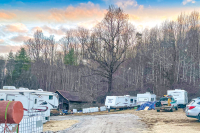Staying alive: MountainTrue protects A.T. ash trees as research progresses against invasive threat
For millions of years, ash trees have grown tall and strong across the landscape today known as the United States — but for now, keeping them alive requires regular treatment with expensive chemicals and $2,000 worth of specialized equipment.
Keeping ash in the Smokies: Land managers, conservation groups work to protect ash from invasive pest
At some point roughly 20 years ago, a shipment from Asia arrived in the United States with a passel of six-legged stowaways lurking in its wooden pallets. Since it was first detected near Detroit in 2002, the emerald ash borer has gnawed its way through ash trees across North America, leaving a swath of destruction across 31 U.S. states and two Canadian provinces — and counting.
The EAB was first spotted in North Carolina in 2013, when it was confirmed in Granville, Person, Vance and Warren counties, a contiguous area in the central part of the state bordering Virginia. Now it’s present in 33 of the state’s 100 counties and continues to spread. WNC counties with confirmed ash borer infestations are Haywood, Swain, Macon, Graham, Buncombe, Madison, Mitchell and Yancey counties — this month, the N.C. Forest Service found EAB on several trees in the Alarka area of Swain County after the beetle was initially found in Bryson City last summer.
Emerald ash borer found in the Pisgah
An infestation of destructive emerald ash borers has been confirmed in the Appalachian Ranger District of the Pisgah National Forest and on private lands along the French Broad River, extending from Marshall to the Tennessee state line.





